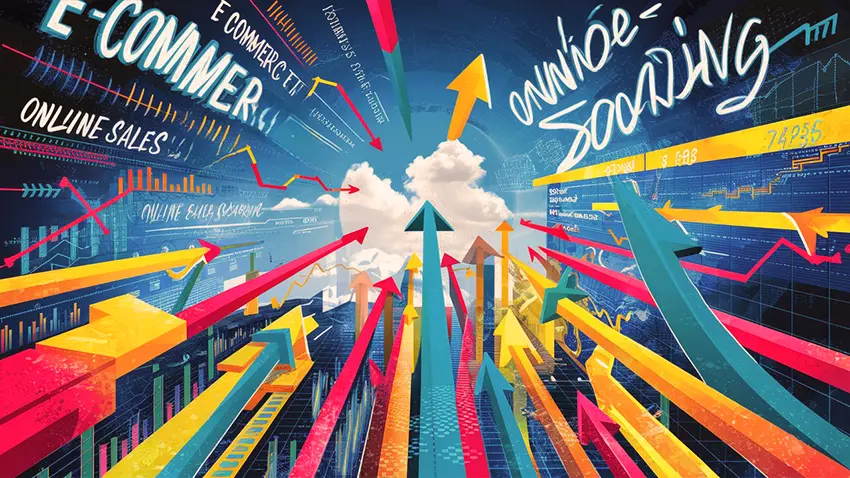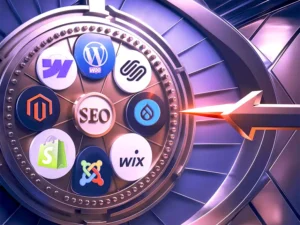If you’re curious about how e-commerce has become so omnipresent today, you’re in the right place. In this article, we’ll delve into the fascinating history of e-commerce and explore its evolution both globally and in Portugal. From the beginnings of long-distance trading to the current era of e-commerce, there is a rich history of e-commerce full of twists and turns that has shaped the world of retail as we know it today.
1. History of E-commerce and the Beginnings of Distance Commerce
Before the digital age, distance commerce already had its roots deeply planted in history. One of the first documented examples of mail order business dates back to the 19th century in the United States, with the emergence of mail order catalogues. Companies such as Montgomery Ward and Sears, Roebuck and Co. began sending printed catalogues to their customers, offering a wide range of products, from clothing to agricultural equipment.
These catalogues revolutionised the way people shopped, allowing them to order products without leaving home. It was a convenient alternative for those who lived in rural areas or didn’t have access to physical shops. Customers simply flicked through the catalogues, selected the items they wanted and sent their orders by post.
In addition to mail order catalogues, there were also other methods of distance commerce. For example, some companies offered home delivery services for products such as milk, bread and eggs. Customers could place their orders over the phone and receive the products directly at home, eliminating the need to go to the grocery store.
Another important milestone in the history of remote commerce was the introduction of telemarketing. Companies began using the telephone as a sales tool, contacting customers to promote their products and services. Although telemarketing was often seen as intrusive, it was an effective way of reaching a large number of people and boosting sales.
These are just a few examples of the early days of distance commerce, which paved the way for the emergence of e-commerce in the digital age. From mail order catalogues to the first telemarketing experiments, distance commerce demonstrated early on its potential to transform the way we shop.
2. The Emergence of the Internet and the E-commerce Boom
In the 1990s, the internet began to become accessible to the general public. With the emergence of the World Wide Web and the popularisation of personal computers, the possibilities for online communication and interaction grew exponentially. It was in this context that e-commerce began to flourish.
2.1 The Amazon Revolution
One of the most significant milestones in this period was the launch of Amazon in 1994 by Jeff Bezos. Initially a modest online bookstore, Amazon quickly expanded its catalogue to include a wide range of products, from electronics to beauty products. The company revolutionised e-commerce by offering a convenient shopping experience, with fast deliveries and exemplary customer service.
2.2. The eBay Online Marketplace
In 1995, eBay emerged, providing a platform where anyone could buy and sell a variety of items, from rare collectables to everyday products. eBay democratised e-commerce, allowing individuals to become entrepreneurs and reach a global audience.
2.3 The Generalised Adoption of the Internet
As the internet became more accessible and consumers became more familiar with online shopping, e-commerce began to grow at a rapid speed. Companies from all sectors began to launch online shops, taking advantage of the unlimited potential of the internet to reach new customers and expand their businesses.
2.4 The Global Expansion of E-commerce
The e-commerce boom has not been limited to the United States. All over the world, new e-commerce companies have sprung up, each offering a unique and innovative shopping experience. E-commerce has become truly global, with consumers from all over the world buying products from foreign companies with just a few clicks.

The emergence of the internet and the boom in e-commerce marked the beginning of a new era in the world of retail. Never before had it been so easy to buy and sell products, and the potential for the growth of e-commerce seemed limitless. This period of explosive growth was just the beginning of a revolution that would continue to transform the way we shop to this day.
3. The Evolution of E-commerce in Portugal
Portugal has witnessed a remarkable evolution in the field of e-commerce in recent decades. Although initially there was a certain reluctance on the part of consumers and companies to adopt e-commerce, the scenario has changed significantly in recent years.
3.1. Late Adoption and Initial Challenges
Portugal was initially slower to adopt e-commerce compared to other European countries. Issues such as the security of online transactions and the preference for traditional payment methods were some of the initial challenges faced by e-commerce in Portugal. In addition, the lack of efficient logistics infrastructure also hampered the growth of e-commerce in the country.
3.2 Accelerated Growth and Impact of the COVID-19 Pandemic
However, in recent years, Portugal has witnessed exponential growth in e-commerce. One of the main reasons for this significant increase has been the impact of the COVID-19 pandemic. With social distancing restrictions and the temporary closure of physical shops during lockdown periods, consumers were forced to turn to e-commerce to fulfil their shopping needs.
3.3 Change in Consumer Behaviour
Increased time spent at home and concerns about security have led many consumers to try e-commerce for the first time. The convenience of being able to shop online and receive products directly at home has become extremely attractive to many Portuguese. This change in consumer behaviour has created new opportunities for e-commerce companies to expand their business and win over new customers.
3.4 Investment in infrastructure and technology
In addition to the impact of the pandemic, the growth of e-commerce in Portugal has also been driven by continued investment in infrastructure and technology. Logistics companies have expanded their operations to facilitate fast and efficient deliveries, while e-commerce companies have invested in more intuitive and secure online platforms.
E-commerce in Portugal is now on an upward trajectory, with a growing number of consumers opting for online shopping and an increase in the number of companies adopting e-commerce as an integral part of their business strategies. With the increasing digitalisation of society and the growth of internet access, the future of e-commerce in Portugal looks promising and full of opportunities.
4. The Future of E-commerce
As we move into the future, it is clear that e-commerce will continue to play a key role in the retail landscape. However, this role will be increasingly influenced by advances in technology, especially with regard to artificial intelligence (AI).
4.1 Artificial Intelligence and Personalisation of the Customer Experience
One of the biggest benefits of AI in e-commerce is the ability to personalise the customer experience. With sophisticated recommendation algorithms, companies can offer highly relevant product suggestions based on customers’ purchase history and browsing behaviour. This personalisation significantly increases the chances of conversion and improves customer satisfaction.
4.2. Optimising Logistics and Stock Management
Artificial intelligence also plays a crucial role in optimising logistics and stock management. With predictive algorithms, companies can anticipate customer demand and ensure that they have the right products in the right places at the right time. In addition, AI can optimise delivery routes and reduce the operating costs associated with logistics.
4.3 Virtual Assistance and Chatbots
Another important application of AI in e-commerce is virtual assistance and chatbots. These automated tools can answer customer questions, provide assistance during the purchasing process and resolve problems quickly and efficiently. With the continuous improvement of natural language processing technology, chatbots are expected to become increasingly sophisticated and capable of offering a customer support experience that is almost indistinguishable from human interaction.
4.4 Predictive Analysis and Decision Making
Finally, artificial intelligence is also key to predictive analysis and strategic decision-making. With the ability to analyse large volumes of data in real time, AI algorithms can identify market trends, predict future demand and help companies make informed decisions about prices, promotions and new product launches.
The future of e-commerce will be strongly driven by artificial intelligence and its ability to automate processes, personalise the customer experience and improve operational efficiency. Companies that invest in integrating AI into their operations will be well placed to thrive in an increasingly digital and competitive market.

Conclusion
As we reflect on the history of e-commerce and his evolution, as well as predicted future developments, it becomes clear that we are entering an exciting era of digital transformation in retail. E-commerce is no longer just a passing trend, but an essential part of the global business landscape.
With the rise of the internet and the boom in e-commerce, we have witnessed a radical change in the way people buy and sell products. Companies like Amazon and eBay have revolutionised the online shopping experience, opening doors to a world of possibilities.
In Portugal, e-commerce has had a particularly remarkable evolution, facing initial challenges and subsequently experiencing exponential growth. The COVID-19 pandemic has further accelerated this growth, leading to the widespread adoption of e-commerce by consumers and businesses.
Looking ahead, it’s exciting to consider the impact that artificial intelligence will have on the future history of e-commerce. From personalising the customer experience to optimising logistics and stock management, AI promises to revolutionise every aspect of the online buying and selling process.
Virtual assistance, intelligent chatbots, predictive analysis and data-driven decision-making are just some of the applications of AI that will shape the future history of e-commerce. Companies that embrace these technologies and invest in integrating them into their operations will be at the forefront of innovation and prepared to thrive in an increasingly digital and competitive market.
In short, the future of e-commerce is bright and full of opportunities. As we move forward on this exciting journey of digital transformation, it is crucial that companies are prepared to embrace change and adopt the emerging technologies that will drive success in the world of online retail.
So the history of e-commerce his a never ending story as the future with AI smiles ahead
A few questions about the history of e-commerce
What is e-commerce?
E-commerce, short for electronic commerce, refers to the buying and selling of goods and services over the internet.
How has e-commerce changed the business world?
E-commerce has democratised commerce, allowing companies of all sizes to reach a global audience and offer their products and services conveniently.
What are the challenges of e-commerce in Portugal?
Some of the main challenges for e-commerce in Portugal include logistics, online security and the adaptation of traditional companies to the digital environment.
What can we expect from the future of e-commerce?
In the future, e-commerce is expected to continue to grow, with more technological advances improving the online shopping experience and making it even more convenient and personalised.
How do I start selling online in Portugal?
To start selling online in Portugal, it’s important to choose a suitable e-commerce platform, invest in digital marketing and ensure a safe and convenient shopping experience for customers.
Follow our complete guide to success.
If you’re curious to learn more about the fascinating world of e-commerce, don’t hesitate to join us on this journey. We’ll provide you with essential strategies and tips for growing e-commerce in Portugal. Get in touch





